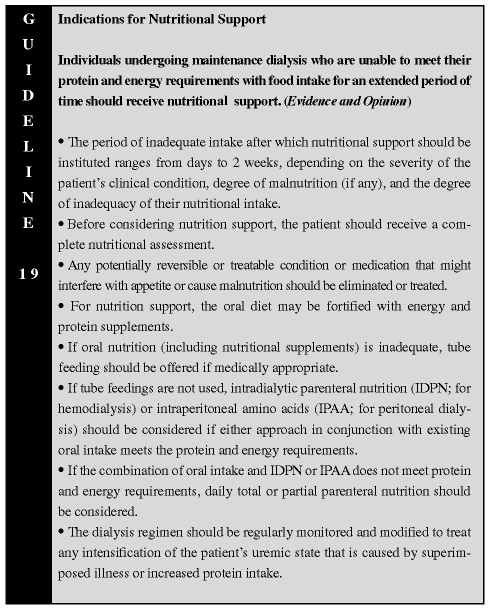
4. Nutritional Counseling and Follow-Up

Many apparently well-dialyzed patients consume approximately 80% or less of their recommended energy intake,164 even when counseled by an experienced renal dietitian. Inadequate nutrient intake may have a variety of causes, including anorexia, inadequate nutritional training, inability to procure or prepare food, psychiatric illnesses, superimposed acute or chronic diseases, mechanical impairments to food intake (eg, lack of dentures), cultural food preferences, and the uremic state, sometimes intensified by underdialysis.165 Hospitalized MD patients often ingest even lower amounts (eg, as low as 66% and 50%, respectively) of protein and energy,138,150 even though protein and energy needs of patients often increase during acute illness. Even in individuals who consumed an adequate diet prior to an illness, food intake may fall to inadequate levels. In the acutely ill hospitalized patient, prescription of an oral diet is often unlikely to improve the intake to a level that maintains neutral or positive nitrogen balance.138,150 These considerations underscore the need for nutrition support for MD patients who sustain inadequate nutrient intake for extended periods of time. There are no large-scale, randomized, prospective clinical trials evaluating the effects of nutrition support in MD patients. Recommendations are therefore based on the experience in nonrenal patients as well as current information regarding nutrition and metabolism of ESRD patients.
Published guidelines and available recommendations suggest that counseling to increase dietary protein and energy intake, nutritional supplements, and tube feeding should be considered before attempting forms of parenteral nutrition in MD patients.166-169 If the intestinal tract is functional, enteral tube feeding is traditionally considered the first line of nutritional therapy in the hospitalized patient who is unable to eat adequately. It has been used successfully to provide nutritional support to infants and children who are receiving MD.170-172 Adult MHD patients have been nourished exclusively with oral supplements.173 There is no reason to suspect that malnourished adult MD patients would differ from infants or children or that acutely ill adult MD patients would differ from acutely ill nondialysis patients in their response to enteral feedings, except for a greater need to restrict the water, mineral, and possibly protein loads in these feedings.173
Advantages to enteral feeding include its ability to provide a patient's total nutritional needs chronically and on a daily basis, to provide balanced nutrients, to administer specialized formulas, to provide a smaller water load than intravenous feedings, to constitute a lower risk of infection than total parenteral nutrition (TPN), and to be less expensive than TPN or IDPN.174,175 Risks of enteral feeding include pulmonary aspiration, fluid overload, reflux esophagitis, and other complications of enteral feeding devices.
MHD patients who satisfy each of the following three criteria may benefit from IDPN:
1. Evidence of protein or energy malnutrition and inadequate dietary protein and/or energy intake.176
2. Inability to administer or tolerate adequate oral nutrition, including food supplements or tube feeding.
3. The combination with oral or enteral intake which, when combined with IDPN, will meet the individual's nutritional needs.
Previously published studies support the use of IDPN for selected MHD patients who are malnourished and eating poorly.169,175,177 Advantages of IDPN as compared to tube feeding or TPN include the following: no need for a dedicated enteral feeding tube or vascular access, ultrafiltration during dialysis (which reduces the risks of fluid overload), and no demands on the time or effort of the patient. Disadvantages to IDPN include provision of insufficient calories and protein to support longterm daily needs (ie, IDPN is given during dialysis for only 3 days out of 7), it does not change patients' food behavior or encourage them to eat more healthy meals, and it is expensive.178
IPAA may increase protein balance in clinically stable, malnourished CPD patients who have low protein intakes.151,152,179-185 The net infusion of 2 L of peritoneal dialysate containing 1.1% amino acids with a peritoneal dwell time of 5 to 6 hours is associated with a retention of about 80% of the amino acids. The amount retained varies directly with peritoneal transport characteristics as determined by peritoneal equilibrium testing.187 Hence, the administration of a single 2-L exchange of 1.1% amino acid dialysate for 5 to 6 hours provides a net uptake of about 17 to 18 g of amino acids, which is greater than the quantity of both protein (about 9 g) and amino acids (about 3 g) removed each day by peritoneal dialysis.187
IPAA may also reduce the infused daily carbohydrate load by about 20%, thereby reducing the risk of hyperglycemia and the tendency to hypertriglyceridemia.188 Most studies of IPAA were not randomized or controlled and used an open (before-after) or crossover design. Intermediate nutrition-related outcome variables (eg, nitrogen-protein balance, serum proteins, and anthropometry) were used in all studies. No study of IPAA has evaluated patient survival, hospitalization, or other clinical outcomes (eg, health-related quality of life). The long-term effects of IPAA on nutritional status and clinical outcomes are unknown. In some patients given IPAA, a mild metabolic acidosis may occur that is readily treatable.
CPD patients who satisfy each of the following three criteria may benefit from IPAA:
Also, in some patients who have difficulty with control of hyperglycemia, hypercholesterolemia, or hypertriglyceridemia that is related to the extensive carbohydrate absorption from peritoneal dialysate, IPAA might reduce serum glucose and lipid levels.